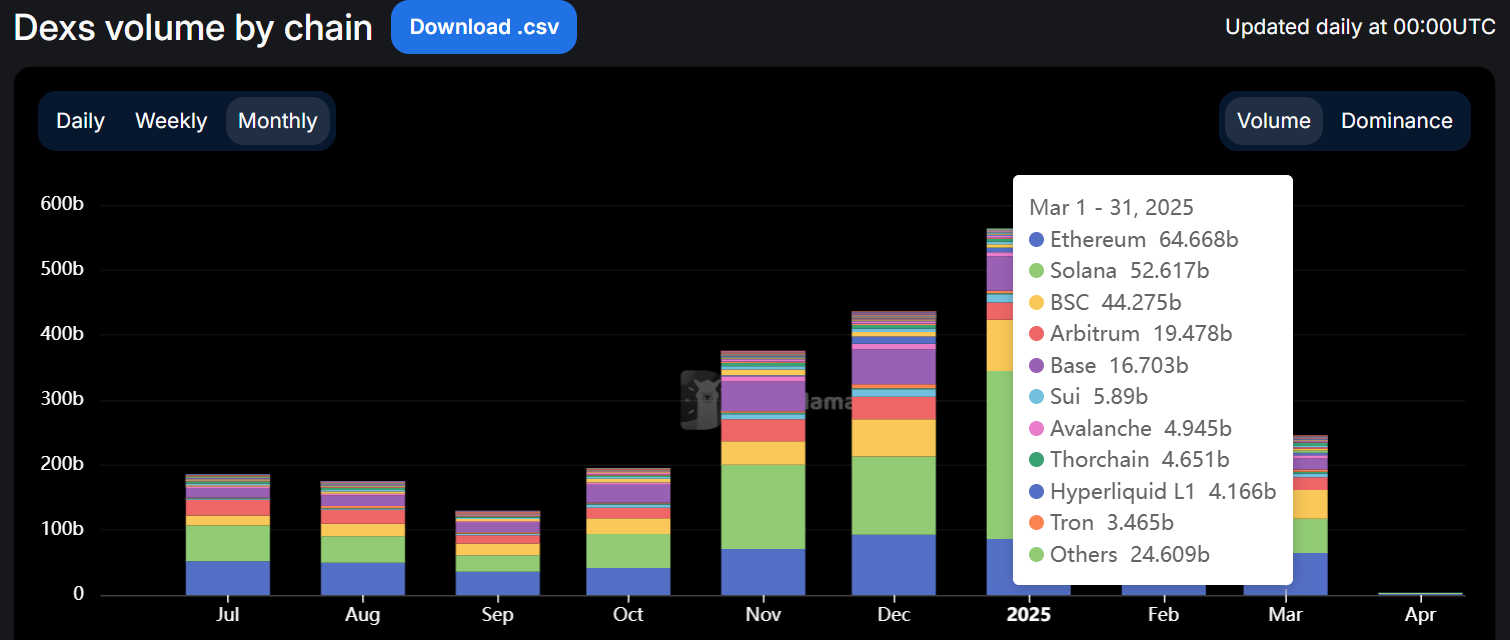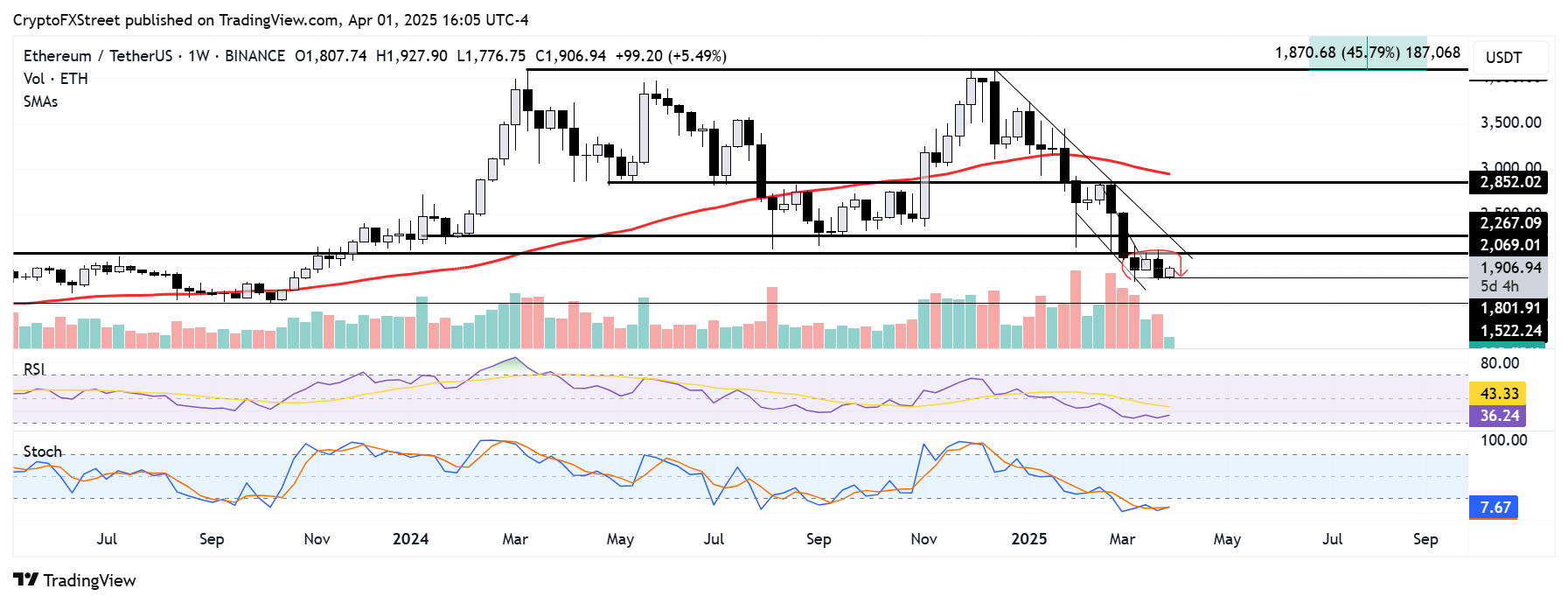Ethereum Price Forecast: ETH eyes Q2 recovery with Pectra mainnet launch and DEX volume dominance
Ethereum price today: $1,910
- Ethereum flipped Solana in March's DEX trading volume following a decline in memecoin activity.
- Derive executive notes that the Pectra upgrade could help fuel a potential ETH rebound by Q2 end.
- ETH failed to validate a rounding top pattern after bouncing off the $1,800 support level.
Ethereum (ETH) is up 5% on Tuesday, beginning Q2 on a positive note after experiencing its worst Q1 performance last quarter. The top altcoin could rebound in Q2 following Ethereum's recent dominance in decentralized exchange (DEX) trading volume and the upcoming Pectra mainnet upgrade.
Ethereum could pick up pace in Q2
Ethereum topped the charts for DEX trading volume among top blockchains in March, surpassing Solana for the first time since September 2024. Ethereum DEXs recorded a total volume of $64.69 billion, higher than Solana's $52.62 billion, according to DefiLlama data.
However, the overall DEX volume is far below levels seen in the past four months, particularly in January, when Solana and Ethereum saw cumulative volumes of $258.49 billion and $86.11 billion, respectively.

DEXs volume by chain. Source: DefiLlama
The huge disparity stems from a sharp decline in memecoin activity following President Donald Trump's tariff announcements, exacerbating the crypto market downtrend.
Despite topping DEX volume in March, ETH extended its downtrend in the month, noting a 21% monthly loss.
Ethereum recorded its worst Q1 performance since 2018 last quarter, with a 45% decline, per Coinglass data. This is also its lowest overall quarterly performance since the bear market of Q2 2022.
However, with new features of the upcoming Pectra upgrade potentially hitting mainnet on April 30, Ethereum could outpace Solana's trading volume and potentially see a rebound in its price in Q2 — which is ETH's second-best quarter historically.
"ETH may experience further downside in April, with stagnating daily transactions and ETF flows. However, there is potential for a rebound by the end of Q2 as the Pectra upgrade goes live and interest returns in the lead-up to ETH CC in Cannes," wrote Sean Dawson, Head of Research at crypto options exchange Derive.
"For ETH, there is a 22% chance that its price will drop below $1,600 by April 25 and a 17% chance that it will rise above $2,000 by the same date," he added, using Derive trading data.
Pectra will introduce several new features to Ethereum, including wallet recovery, transaction batching and blob expansion.
Ethereum Price Forecast: ETH bounces off $1,800, fails to validate rounding top pattern
Ethereum saw $45.80 million in futures liquidations in the past 24 hours, per Coinglass data. The total amount of long and short liquidations accounted for $9.73 million and $36.07 million, respectively.
ETH bounced off the $1,800 support, rising 5% on Tuesday after failing to validate a rounding top pattern on the weekly chart. The top altcoin now faces a hurdle at $2,070, a resistance that could be gaining strength, considering ETH has seen a rejection near it for two consecutive weeks.

ETH/USDT weekly chart
If ETH smashes the resistance levels at $2,070, $2,260 and a descending trendline extending from December 16, it could begin a major uptrend. However, a decline below $1,800 could see ETH finding support at $1,500.
The Relative Strength Index (RSI) is below its neutral while the Stochastic Oscillator (Stoch) has remained in the oversold region since February, indicating dominant bearish momentum. The RSI and Stoch have to sustain a firm cross above their moving averages and neutral levels to validate a bullish outlook.
Ethereum FAQs
Ethereum is a decentralized open-source blockchain with smart contracts functionality. Its native currency Ether (ETH), is the second-largest cryptocurrency and number one altcoin by market capitalization. The Ethereum network is tailored for building crypto solutions like decentralized finance (DeFi), GameFi, non-fungible tokens (NFTs), decentralized autonomous organizations (DAOs), etc.
Ethereum is a public decentralized blockchain technology, where developers can build and deploy applications that function without the need for a central authority. To make this easier, the network leverages the Solidity programming language and Ethereum virtual machine which helps developers create and launch applications with smart contract functionality.
Smart contracts are publicly verifiable codes that automates agreements between two or more parties. Basically, these codes self-execute encoded actions when predetermined conditions are met.
Staking is a process of earning yield on your idle crypto assets by locking them in a crypto protocol for a specified duration as a means of contributing to its security. Ethereum transitioned from a Proof-of-Work (PoW) to a Proof-of-Stake (PoS) consensus mechanism on September 15, 2022, in an event christened “The Merge.” The Merge was a key part of Ethereum's roadmap to achieve high-level scalability, decentralization and security while remaining sustainable. Unlike PoW, which requires the use of expensive hardware, PoS reduces the barrier of entry for validators by leveraging the use of crypto tokens as the core foundation of its consensus process.
Gas is the unit for measuring transaction fees that users pay for conducting transactions on Ethereum. During periods of network congestion, gas can be extremely high, causing validators to prioritize transactions based on their fees.

